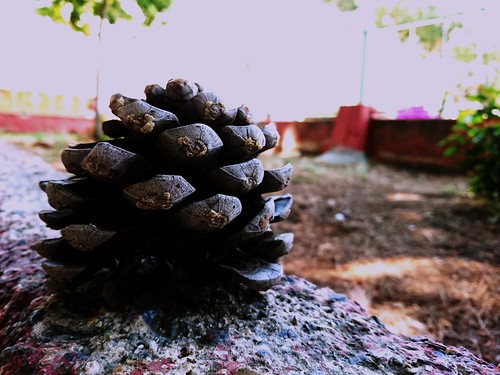Diogenous cell plus the width of its tip and conidial hila, also remarkable in H. odoratus. Likewise, annellidic tips of conidiogenous cells or those using a quick rachis, both found in the anamorph of H. rosellus, are lacking get NSC600157 inside the tropical species. In C. protrusum every locus, formed at the tip of a modest protrusion, presumably produces a single conidium, with up to 12 conidia observed in the apex of every conidiogenous cell. The anamorph of H. gabonensis provides an unusual phenomenon that illustrates the plasticity from the anamorphic state. The colonies on different media start growing by making profusely branched conidiophores and comparatively compact, 1-septate conidia from the uppermost and intercalary loci. Subsequently, a largeconidial anamorph, practically indistinguishable from C. cubitense, types in the majority of the cultures at unique occasions and place. Equally unique is H. aconidialis, representing the only species in the genus not found conidiating on the host or inside the fresh isolations on distinct culture media.Chlamydospores or thick-walled structuresMost from the species treated herein generate thick-walled, subglobose cells, referred to as chlamydospores, in nature too as in culture. In nature they may be identified amongst the mycelium on which the conidiophores develop or near perithecia. In these fungal parasites chlamydospores naturally serve as survival structures to overcome periods amongst the availability of host fruiting bodies at the same time as unfavourable conditions like drought. While seemingly  far more significant for parasites of soft, ephermeral fruiting bodies of agarics, they’re identified also in cultures of species isolated in the more persistent basidiomata of wood-rotting aphyllophores. On organic substrata, the chlamydospores happen as single cells or are held in brief straightforward chains. In cultures these could be followed by the formation of a lot more complex aggregations. Generally, the chains of swollen and thick-walled cells grow out from a related or easy intercalary cell on submerged or aerial hyphae. In some species the chains form branches and can develop into an irregular to globose mass of cells visible below the stereomicroscope. These are PubMed ID:http://www.ncbi.nlm.nih.gov/pubmed/21258973 generally light, nearly colourless to pale ochraceous, soft, and lack inner structure characteristic of correct sclerotia. The dark, hard, purplish brown sclerotia-like aggregations, widespread in temperate red Hypomyces species, were identified only in C. paravirescens and C. protrusum.CollectionsfromtropicalAmericalackinganamorph dataOver 20 specimens of red Hypomyces collected from tropical Central, North and South America within the 20th century are preserved at NY as H. rosellus. The US National Fungus Collection (BPI) holds fewer such specimens, a few of that are accessioned as H. odoratus. Many of the specimens comprise purplish red perithecia developed in paler subiculum as common from the members of your aurofusarin group of Hypomyces. The perithecia measure 300430 m in height and 20040 m in length, with papilla 5050 m high. In spite of the similarity in perithecia, the morphology of ascospores clearly distinguishes all the studied mature collections from H. rosellus. The fusiform ascospores, 21.09.0 (5.05.57.5 m, and their apiculi, 2.0.5(.5) m, are shorter than in H. rosellus. Ascospore measurements, which includes the a lot more diagnosticRed-PigMented tRoPical Hypomyces mean values of length and width, fall in the variety described for the cultured specimens of H. samuelsii. In addition, the grossly warted to tuberculate o.
far more significant for parasites of soft, ephermeral fruiting bodies of agarics, they’re identified also in cultures of species isolated in the more persistent basidiomata of wood-rotting aphyllophores. On organic substrata, the chlamydospores happen as single cells or are held in brief straightforward chains. In cultures these could be followed by the formation of a lot more complex aggregations. Generally, the chains of swollen and thick-walled cells grow out from a related or easy intercalary cell on submerged or aerial hyphae. In some species the chains form branches and can develop into an irregular to globose mass of cells visible below the stereomicroscope. These are PubMed ID:http://www.ncbi.nlm.nih.gov/pubmed/21258973 generally light, nearly colourless to pale ochraceous, soft, and lack inner structure characteristic of correct sclerotia. The dark, hard, purplish brown sclerotia-like aggregations, widespread in temperate red Hypomyces species, were identified only in C. paravirescens and C. protrusum.CollectionsfromtropicalAmericalackinganamorph dataOver 20 specimens of red Hypomyces collected from tropical Central, North and South America within the 20th century are preserved at NY as H. rosellus. The US National Fungus Collection (BPI) holds fewer such specimens, a few of that are accessioned as H. odoratus. Many of the specimens comprise purplish red perithecia developed in paler subiculum as common from the members of your aurofusarin group of Hypomyces. The perithecia measure 300430 m in height and 20040 m in length, with papilla 5050 m high. In spite of the similarity in perithecia, the morphology of ascospores clearly distinguishes all the studied mature collections from H. rosellus. The fusiform ascospores, 21.09.0 (5.05.57.5 m, and their apiculi, 2.0.5(.5) m, are shorter than in H. rosellus. Ascospore measurements, which includes the a lot more diagnosticRed-PigMented tRoPical Hypomyces mean values of length and width, fall in the variety described for the cultured specimens of H. samuelsii. In addition, the grossly warted to tuberculate o.